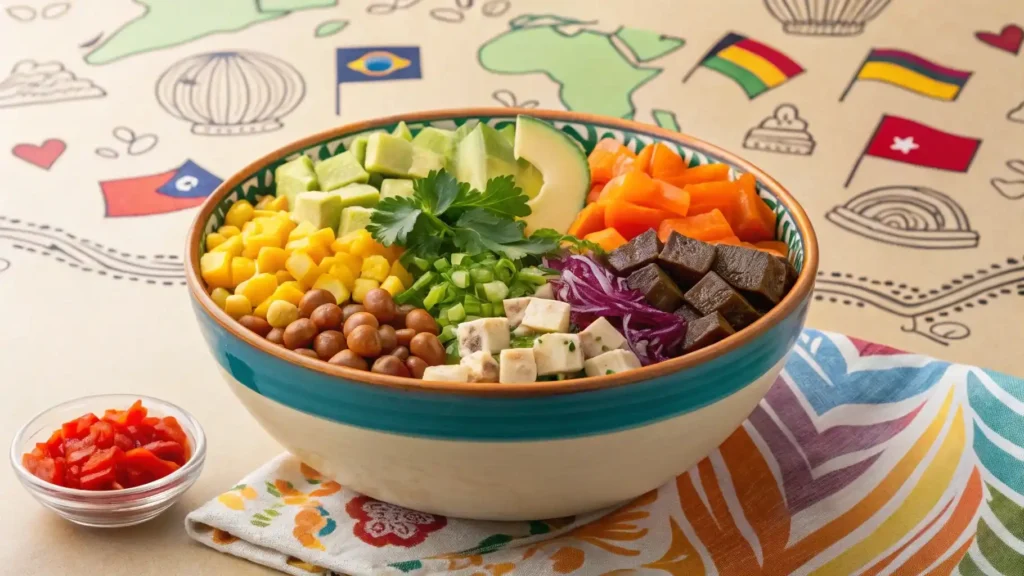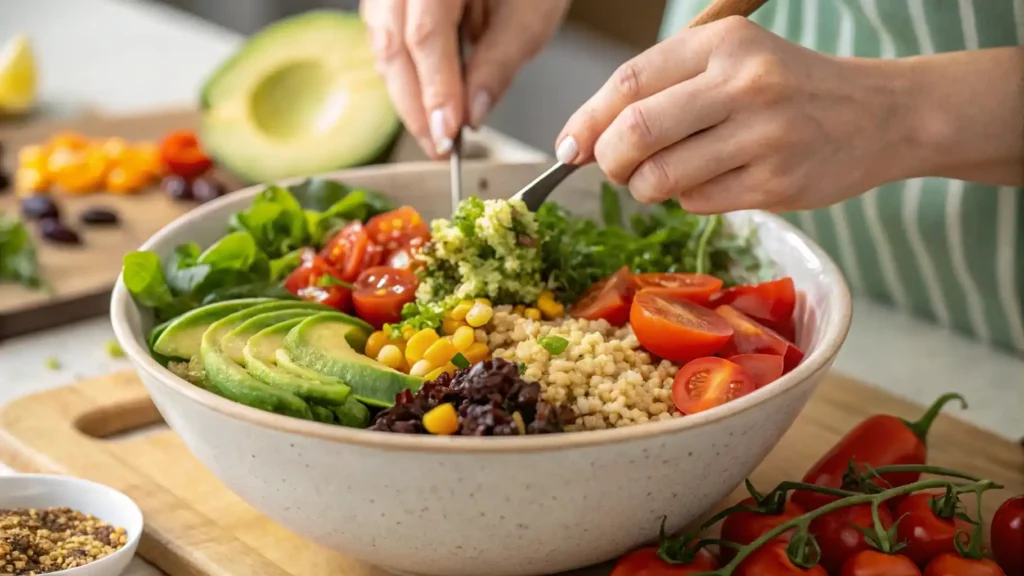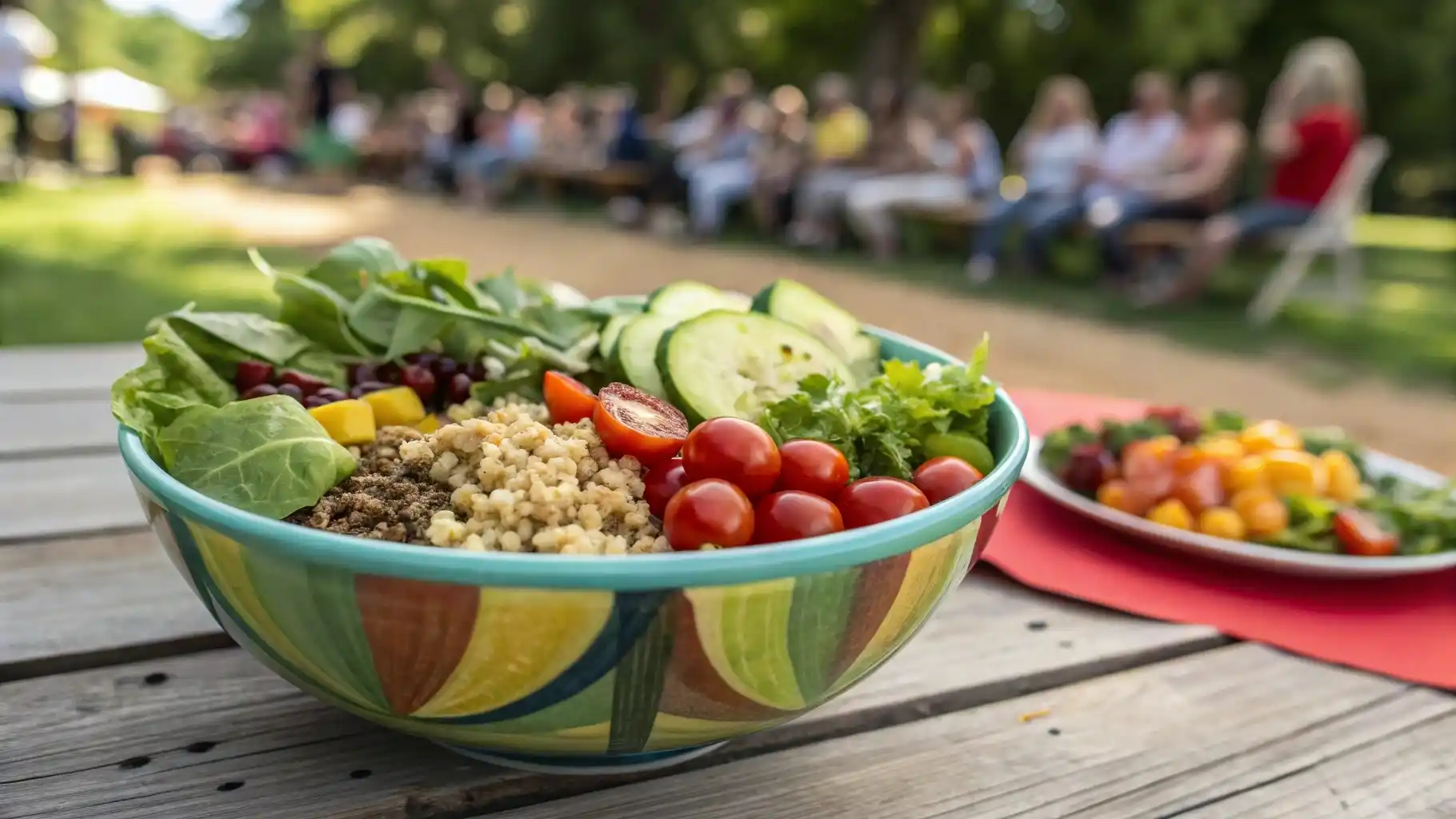The salad bowl metaphor offers a vivid and powerful way to understand cultural diversity in societies. Unlike the “melting pot” idea, where different cultures blend into a homogeneous whole, the salad bowl celebrates individual uniqueness, allowing each element to retain its identity while contributing to a richer whole. This article dives deep into the concept of the salad bowl, exploring its cultural implications, historical significance, and even its influence on food culture. Let’s discover how this metaphor connects to themes of diversity, nutrition, and unity.
What is the Salad Bowl Concept?
Defining the Salad Bowl Metaphor
The salad bowl concept is a metaphor often used to describe multicultural societies. In this model, individuals from diverse backgrounds coexist, maintaining their distinct cultural identities while contributing to the society’s overall character. Imagine a salad where the lettuce, tomatoes, cucumbers, and dressing all combine to create something delicious yet retain their unique qualities. Similarly, a salad bowl society embraces the coexistence of various ethnicities, traditions, and languages without forcing assimilation.
This metaphor emerged in the 20th century as a counterpoint to the “melting pot,” which suggested the blending of different cultures into one. Unlike the melting pot, the salad bowl values the individuality of each “ingredient,” fostering a society where differences are appreciated rather than erased.
Salad Bowl vs. Melting Pot: Key Differences
The melting pot emphasizes assimilation, where people adopt a common culture, often losing their unique identities. On the other hand, the salad bowl approach highlights pluralism, advocating for coexistence and mutual respect.
For example:
- In a melting pot society, immigrants might feel pressured to abandon their native customs in favor of dominant cultural norms.
- In a salad bowl society, those same immigrants can celebrate their heritage while participating in shared societal values.
Ultimately, the salad bowl promotes a richer, more vibrant community. It’s a philosophy that supports diversity and inclusion while fostering a sense of belonging for everyone involved.
Stay tuned as we uncover how this metaphor shapes cultural dynamics and why it resonates so deeply in modern societies.
Cultural Implications
Embracing Diversity in Society

The salad bowl highlights the beauty of cultural diversity. In societies adopting this model, individuals from different backgrounds coexist harmoniously without sacrificing their unique identities. It fosters mutual respect and understanding by encouraging the preservation of languages, customs, and traditions.
For example, cities like Toronto or New York thrive as salad bowl societies, where ethnic enclaves such as Chinatown or Little Italy contribute to the overall cultural landscape. This diversity strengthens social cohesion by promoting inclusivity and reducing cultural barriers.
Examples of Salad Bowl Societies Worldwide
Around the globe, many nations embody the salad bowl concept. Canada’s multicultural policy encourages immigrants to retain their heritage while becoming active members of society. Similarly, Singapore’s neighborhoods reflect a harmonious blend of Malay, Chinese, Indian, and Eurasian cultures.
These examples showcase how diversity can enrich society. By embracing the salad bowl, nations can create communities that are vibrant, inclusive, and innovative.
Salad Bowl in the United States
Why is the US Called a Salad Bowl?
The United States is often referred to as a salad bowl due to its vast cultural diversity. Unlike the melting pot, which implies assimilation, the salad bowl metaphor recognizes the distinctiveness of various ethnic groups. Immigrants from countries such as Mexico, India, and Vietnam have brought their cuisines, festivals, and traditions, shaping America’s identity.
Historical Evolution of the Metaphor
The salad bowl gained prominence in the late 20th century as an alternative to the melting pot. It emerged in response to criticisms of forced assimilation, promoting a vision where immigrants maintain their heritage while contributing to a unified society.
Ethnic Enclaves and Their Role in US Society
Ethnic enclaves like Koreatown or Greek Town demonstrate the salad bowl in action. These communities preserve cultural traditions, providing spaces for language, cuisine, and celebrations to thrive. At the same time, they contribute to the broader American identity, enriching the nation with diverse perspectives and flavors.
Want to explore a refreshing salad recipe? Check out Spring Roll Salad: The Ultimate Bowl of Crunchy, Refreshing Goodness for inspiration.
The Salad Bowl in Food Culture
Significance of Salads in Culinary Traditions
Salads have long held a place of honor in global cuisines. They’re not just side dishes but a celebration of fresh ingredients and balance. The salad bowl is the ultimate representation of variety bringing together crisp vegetables, hearty grains, creamy dressings, and bold seasonings.
From Mediterranean tabbouleh to Mexican taco salads, this culinary tradition showcases the beauty of diversity on a plate. Salads embody the salad bowl concept by highlighting individual ingredients that come together to create something greater than the sum of their parts.
How Salad Bowls Represent Nutrition and Health
Salads are a fantastic way to pack nutrition into a single meal. With the right combination of ingredients, a salad bowl can deliver essential vitamins, fiber, and protein, making it a balanced and wholesome choice.
For instance, adding leafy greens like kale, hearty grains like quinoa, and a sprinkling of nuts or seeds not only elevates flavor but also boosts the dish’s health benefits. The versatility of a salad bowl means you can mix and match ingredients to suit your taste while ensuring a well-rounded meal.
If you’re inspired to try a new recipe, explore the Spring Roll Salad: The Ultimate Bowl of Crunchy, Refreshing Goodness.
Best Practices for Making a Salad Bowl
Choosing the Right Ingredients

The secret to a standout salad bowl is in the ingredients. Start with a base of fresh greens, then add a mix of textures like crunchy vegetables, creamy cheeses, and chewy grains. Don’t shy away from bold flavors like citrus or tangy dressings; they can transform a simple salad into a gourmet experience.
What Bowls Are Best for Salads?
Using the right bowl can enhance your salad bowl experience. Large, wide bowls allow for easy mixing and better presentation. Glass or ceramic options are great for showcasing colorful ingredients, while wooden bowls add a rustic touch.
Creating Balance and Flavor in Your Salad
A perfect salad bowl strikes a balance between taste and nutrition. Combine sweet and savory elements, like roasted sweet potatoes with salty feta. Add crunch with toasted nuts or seeds, and finish with a flavorful dressing to tie everything together.
FAQs About Salad Bowls
Why is the US Called ?
The United States is often called a salad bowl because it represents a society where various cultures coexist without losing their unique identities. Unlike the melting pot, which implies complete assimilation, the salad bowl celebrates the individuality of each culture, much like the distinct ingredients in a salad contribute to its overall flavor.
This metaphor underscores the importance of diversity in shaping the nation’s identity. From language to cuisine, each cultural group enriches the country while maintaining its traditions.
What Bowls Are Best for Salads?
The choice of bowl can elevate your salad experience. Wide, shallow bowls are ideal for mixing ingredients, while deeper ones work well for layered salads. Materials also matter ceramic and glass are perfect for highlighting the vibrant colors of your salad bowl, while wood adds a rustic, natural touch.
Where Do the Kardashians Get Their Big Bowls of Salad?
If you’ve seen the Kardashians enjoying their iconic salad bowls, you might wonder where they get them. Their salads are often sourced from Health Nut, a California-based eatery known for its fresh, customizable salads served in large, reusable containers.
How Healthy Are Salad Bowls?
Salad bowls are a powerhouse of nutrition, provided they’re made with wholesome ingredients. Packed with greens, lean proteins, and healthy fats, they deliver vitamins, minerals, and fiber. To keep them healthy, avoid heavy dressings and excessive toppings, focusing instead on fresh, nutrient-rich ingredients.
Conclusion: Embracing the Salad Bowl Concept
Reflection on Diversity and Integration
The salad bowl metaphor reminds us that diversity is a strength, not a challenge. It encourages societies to value individual contributions while fostering unity. By appreciating differences, we create environments that are more inclusive, innovative, and enriching.
Moving Towards a Unified Yet Diverse Society
Embracing the salad bowl concept requires a shift in mindset one that moves away from assimilation and towards integration. When we allow individuals and cultures to flourish in their unique ways, we build a richer, more harmonious world.
Whether in culture, cuisine, or daily life, the salad bowl teaches us that unity doesn’t mean uniformity. It’s about celebrating what makes us unique while working together for a shared future. So next time you enjoy a literal salad bowl, think about how its ingredients mirror the beauty of a diverse and united society.
Applying the Salad Bowl Concept to Personal Growth
Finding Balance in Individual Identity
The salad bowl metaphor isn’t just for society it’s also a great way to think about personal growth. Much like the ingredients in a salad bowl come together to create a balanced dish, our lives can benefit from embracing different experiences, values, and influences.
Instead of losing ourselves to one way of thinking or being, the salad bowl encourages us to celebrate our unique traits while integrating lessons from others. This mindset allows for a richer, more fulfilling personal identity.
Learning from Diversity
Embracing the salad bowl approach in life means seeking out diverse perspectives. Whether it’s through travel, conversations, or learning about other cultures, exposure to new ideas broadens our horizons. This openness fosters empathy, adaptability, and a deeper understanding of the world.
For example, trying new cuisines or traditions can inspire fresh ideas in your own life. The salad bowl reminds us that diversity isn’t just enriching it’s essential for growth.
The Salad Bowl as a Model for Global Unity
Unity Through Diversity
On a global scale, the salad bowl metaphor is a powerful symbol for unity. By recognizing and respecting cultural differences, nations can work together towards shared goals without erasing individuality. This idea promotes collaboration while preserving the unique flavors of each culture.
International events, like the Olympics or cultural festivals, are prime examples of the salad bowl in action. They bring together people from all walks of life to celebrate both unity and diversity, proving that we can coexist harmoniously while maintaining our distinct identities.
A Recipe for a Harmonious World
Much like crafting the perfect salad bowl, building global unity requires balance. It involves listening, respecting, and learning from one another. When we treat diversity as an asset rather than a challenge, we create a foundation for peace, innovation, and shared success.
The salad bowl concept reminds us that the world is better when its “ingredients” work together, each contributing its unique essence to a more flavorful whole. By embracing this idea, we can create a future that values collaboration over conflict, ensuring that everyone’s voice is heard and appreciated.
If this concept inspires you, try creating your own diverse and flavorful bowl with ideas from Taco Bowl or explore fusion creativity with a Street Corn Chicken Rice Bowl: A Flavor-Packed Delight.
For more exciting recipes and inspirations, visit Timer Recipes.

